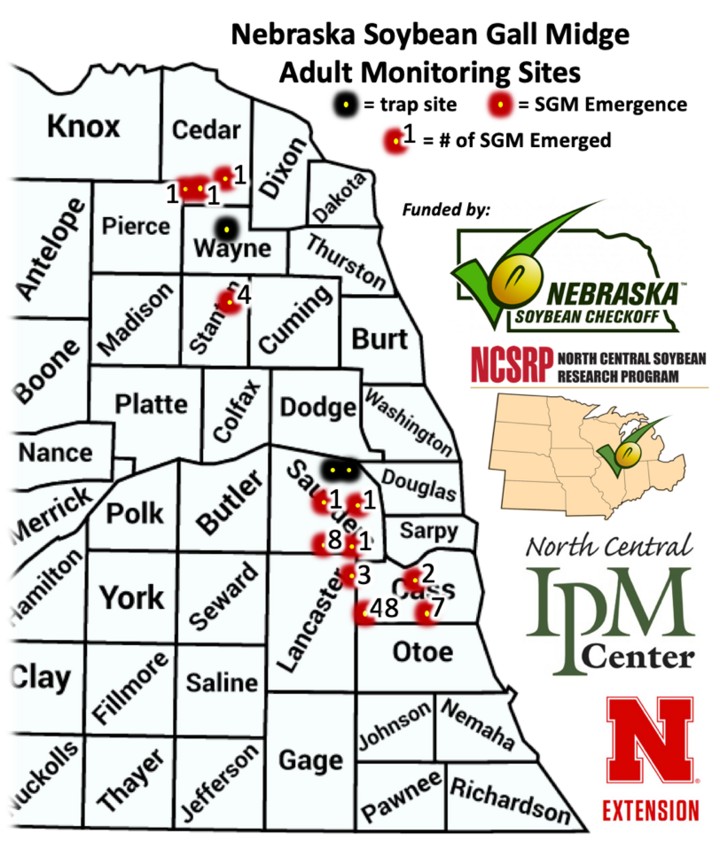Emergence of soybean gall midge adults has continued to increase since our last alert on Saturday, June 15. Figure 1 shows gall midge emergence as of June 18.

Adult numbers have increased rapidly in southern Cass County with 10 or more adults collected each day since Sunday. Adult emergence was also found in northern Cass County but with lower numbers per field. Three adult males were observed in northeast Lancaster County. South and central Saunders County has had emergence with most sites at very low levels (e.g., one per site). This morning, south central Saunders saw an increase in gall midge numbers to seven, but they were primarily associated with spring-tilled portions of the field, which may have accelerated emergence. Male and female gall midge (Figure 2) have been observed in southern Cass County and southern Saunders, and a single female adult midge was found at the Eastern Nebraska Research and Extension Center near Mead.
On June 17, in Stanton County near Pilger four adults (two females and two males) were collected. No adult midges were found today. Near Randolph in Cedar County one female was collected at the eastern site and one male was collected at the western site. A single male was observed near Belden in Cedar County.
Growers with a history of soybean gall midge may want to take action in areas where more than one soybean gall midge per site has been collected (Figure 2). Sites are currently being sampled daily for gall midge emergence. We will continue to provide updates in CropWatch.
The following information is a reprint from the June 15 CropWatch article:
I’m in an area with soybean gall midge emergence. Now what?
Because this is a new soybean pest, we do not as yet have research-based recommendations; however, we have developed some preliminary recommendations based on our recent soybean gall midge observations. Those who have experienced significant economic losses from soybean gall midge are advised to use an insecticide with residual activity. This application should be made as soon as possible after adult soybean gall midge emergence occurs in your area. We don’t recommend making an application if a field can’t be sprayed within six days of first adult emergence of soybean gall midge.
Research is currently being conducted on the timing of insecticides relative to the emergence of soybean gall midge to determine a window of efficacy for insecticide applications. Closely related insects to this species have a very short life span as adults so we expect that all of the egg laying will be done within that time period, greatly reducing the efficacy of an insecticide application. Also, be sure to adhere to the label when applying a pesticide.
Making an Insecticide Application

For your benefit, it’s best to not spray in two to three areas along the edge of the field (50 - 100 feet long and 90-120 feet wide, depending on the length of the boom) to determine whether the insecticide worked. If you’re in Nebraska and need assistance with evaluating damage later in the season, contact Extension Entomologists Justin McMechan (402-624-8041) or Tom Hunt (402-584-3863). Figure 3 provides a visual demonstration of what sprayed and unsprayed (none) might look like along a field edge.
Related CropWatch Articles
Emergence of Soybean Gall Midge in Southern Cass County, NE (June 14, 2019)
Orange Gall Midge in Soybeans (Aug. 1, 2018)
Survey of Orange Gall Midge in Nebraska: A Potential Pest of Soybeans (Aug. 23, 2018)

